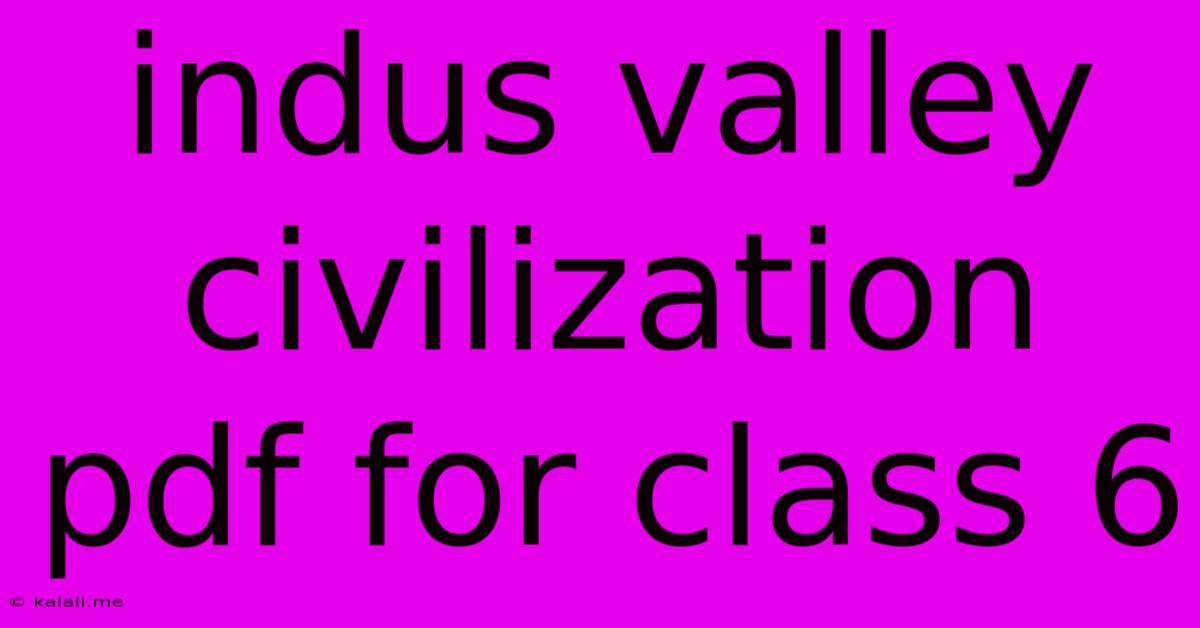Indus Valley Civilization Pdf For Class 6
Kalali
Jun 13, 2025 · 3 min read

Table of Contents
Indus Valley Civilization PDF for Class 6: A Comprehensive Guide
This article serves as a comprehensive guide to the Indus Valley Civilization, specifically tailored for class 6 students. While I cannot provide a downloadable PDF, I will offer a detailed overview suitable for study and research, covering key aspects of this fascinating ancient civilization. This detailed explanation will help you understand the civilization better than any simple PDF could. Remember to always cross-reference information with your textbooks and other reliable educational resources.
What was the Indus Valley Civilization?
The Indus Valley Civilization, also known as the Harappan Civilization, was one of the world's earliest urban civilizations. Flourishing during the Bronze Age (approximately 3300-1300 BCE), it extended across a large area of the Indian subcontinent, encompassing parts of present-day Pakistan and Northwest India. It's renowned for its advanced urban planning, sophisticated drainage systems, and standardized weights and measures, showcasing a high level of societal organization.
Key Features of the Indus Valley Civilization:
-
Urban Planning: Indus cities were meticulously planned, with grid-like street patterns, well-developed drainage systems, and public baths. Mohenjo-daro and Harappa are prime examples of this advanced urban design. The advanced engineering demonstrates a sophisticated understanding of city planning and sanitation, far ahead of its time.
-
Drainage System: The sophisticated drainage system is a testament to the civilization's understanding of public health. Houses were connected to covered drains that ran along the streets, leading to larger, main drains. This was a remarkable feat of engineering for its time.
-
Standardized Weights and Measures: The use of standardized weights and measures indicates a highly organized and centralized administration. This suggests efficient trade and economic systems across the vast civilization.
-
Agriculture: The Indus people were skilled farmers, cultivating crops like wheat, barley, peas, and cotton. This agricultural success fueled the growth of their urban centers. Irrigation techniques were likely also employed.
-
Trade and Commerce: Evidence suggests extensive trade networks connecting the Indus Valley Civilization with Mesopotamia and other regions. The discovery of seals and artifacts from distant lands supports this conclusion.
-
Writing System: The Indus script remains undeciphered, presenting a significant challenge to historians. Though we can't read it, the existence of a unique writing system demonstrates a complex system of communication.
-
Art and Crafts: The Indus people were skilled artisans, producing high-quality pottery, jewelry, and sculptures. Their craftsmanship is reflected in the intricate details found on their artifacts.
-
Religious Beliefs: While the religious beliefs of the Indus people are not fully understood, evidence suggests the possible worship of Mother Goddess figures and animals. The discovery of artifacts and religious symbols help us piece together our understanding.
Major Cities of the Indus Valley Civilization:
-
Mohenjo-daro: One of the largest cities, famous for its Great Bath and well-planned layout.
-
Harappa: Another major city, also showcasing impressive urban planning and sophisticated infrastructure.
-
Kalibangan: Known for its unique features, including fire altars and evidence of agricultural practices.
-
Lothal: Located near the coast, it possessed a remarkable dockyard, indicating its importance in maritime trade.
The Decline of the Indus Valley Civilization:
The reasons for the decline of the Indus Valley Civilization are still debated among historians. Theories range from climate change and environmental degradation to invasions and internal conflicts. Further research is needed to fully understand this important transition.
This overview provides a solid foundation for understanding the Indus Valley Civilization. Remember to utilize your class textbooks and other supplementary resources for a more in-depth study. By exploring these facets, you will gain a comprehensive appreciation of this significant chapter in human history.
Latest Posts
Latest Posts
-
The Three Parties Involved With A Check Are
Jun 14, 2025
-
31 9 As A Mixed Number
Jun 14, 2025
-
Lcm Of 3 5 And 11
Jun 14, 2025
-
A Life Insurance Policy Would Be Considered A Wagering
Jun 14, 2025
-
A Measure Of The Force Of Gravity On An Object
Jun 14, 2025
Related Post
Thank you for visiting our website which covers about Indus Valley Civilization Pdf For Class 6 . We hope the information provided has been useful to you. Feel free to contact us if you have any questions or need further assistance. See you next time and don't miss to bookmark.